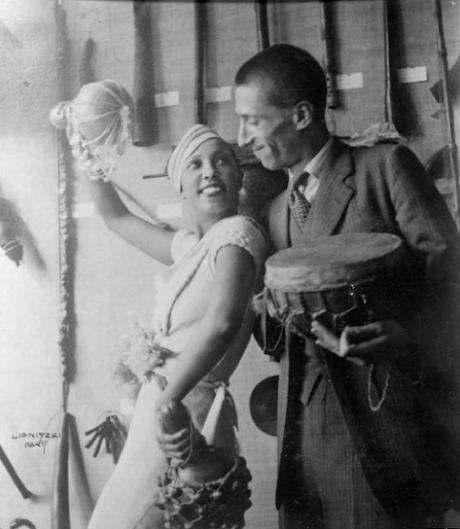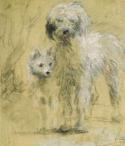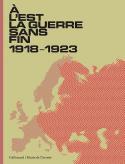Art Of The Day Weekly
#533 - from 15 November 2018 to 21 November 2018

Joséphine Baker and Georges Henri Rivière in front of a showcase at the exhibition on the Dakar-Djibouti mission at the musée d’Ethnographie du Trocadéro, 1933. Gelatin photograph Boris Lipnitzki, negative Mucem, Marseille © Studio Lipnitzki.
IN THE AIR
How Rivière revolutionized popular traditions
MARSEILLE –Marseille is paying a tribute to him. But it could have been done in a typical cabin of the region of Aubrac, or in Africa, or in a Parisian cabaret from the Roaring Twenties such as the famous Bœuf sur le toit. Georges Henri Rivière (1897-1985) is almost completely forgotten today, and yet he synthesized all of these influences. He was born in Montmartre, but was underwent a great influence from his family vacations in Brittany, was a choirmaster and a jazz pianist with his artist friends, and at the age of 30he discovered his true vocation when he prepared a colossal exhibition on pre-Colombian art. He then slipped into the musée d’Ethnographie at the Trocadéro, and set up a great number of missions to Africa with his mentor Paul Rivet. But he discovered another continent that was at risk, that of folk art and traditions. He organized collection-surveys in various regions throughout France, from Provence to the Aubrac, from Alsace to Brittany, and spent 40 years of his life creating what would become the musée des ATP (museum of folk art and traditions), first in a wing of the palace of Chaillot, and then in a building in the Jardin d’acclimatation, designed by Jean Dubuisson and inaugurated in 1972, which is currently under renovation under the aegis of the Fondation Louis Vuitton. The museum presented an extensive collection and the reconstitution of indigenous habitats, but it no longer exists. His collection though is partially kept at the Mucem, of which it was the first capsule. The time had come for Rivière, a central and iconic figure of the 20th century, with all his contrasting connections, from peasants to the Dada, to finally be honored. The presentation here is as varied as his own interests were, from drawings by Picabia, horse collars, African masks and posters of May 68.
• Georges Henri Rivière. Voir c’est comprendre at the Mucem, from 14 November 2018 to 4 March 2019.
EXHIBITIONS

Pablo Palazulo, Alborada, 1952, oil on canvas, 101 x 220 cm. Collection La Caixa Arte Contemporáneo.
Paris, the Fifties were very cosmopolitan
MADRID – When we think of foreign artists in Paris, we immediately think of the Roaring Twenties, Montparnasse, Man Ray, Modigliani and Picasso. Or the Belle Epoque, in Montmartre or in the fancy districts with Zuloaga and Boldini… What about the years around 1950? We usually brush them aside. And yet, then too, painters from all over the world came to the French capital, part of them were baptized “the second school of Paris”. The exhibition brings together a part of this beautiful world, mixing Spaniards who were mostly against Franco (Clavé, Chillida or Palazuelo), Chinese artists (Zao Wou-Ki), as well as Americans (Ellsworth Kelly, Tamayo the Mexican) or people from nearby, like the Swiss Tinguely.
• París pese a todo at the Reina Sofía museum, from 21 November 2018 to 22 April 2019.
Gainsborough and Co.
LONDON – He was one of the greatest portrait artists of the 18th century, describing a world of elegant and jaded aristocrats. The recent revelation that the career of Thomas Gainsborough (1727-1788) may have been boosted thanks to the dramatic end of an uncle, murdered, adds some spice to his bland painting. If it hadn’t been for the inheritance of this rich uncle the little lad from Suffolk would never have had the means to try his luck in London. His family is brought together here, in some fifty paintings mostly brought from private collections. For the first time, we will see a dozen portraits dedicated to his dear daughters, as well as his wife Margaret, including their dogs Tristram and Fox.
• Gainsborough’s Family Album at the National Portrait Gallery, from 22 November 2018 to 3 February 2019.
Nomads, two times
PARIS – We know about the camps where the Spanish Republicans were locked up, then the Jews, as well as those from Gurs, Argelès and Rivesaltes. We know a lot less about the other thirty buildings, mostly in the occupied zone (Pontivy, Montreuil-Bellay, Jargeau, Barenton, Moloy) where, as of 1940, Nomads were locked up. This exhibition-dossier reminds us of this reality, and the delayed closing of the last camp, in 1946.
• L’internement des Nomades, une histoire française at the Mémorial de la Shoah, from 14 November 2018 to 17 March 2019.
BOOKS
Looking towards the East
There has been a lot of talk recently about war, in a Surrealist atmosphere, in which the celebration of the end of a deadly conflict was above all an opportunity to exchange belligerent accusations. We only hope that the frightening proverb, according to which those who have forgotten history are condemned to repeat it, will not come true. But we can’t ignore that the knowledge of these facts is very superficial for some of our leaders. This catalogue, which accompanies an exhibition at the musée de l’Armée until 20 January, gives us the opportunity to plunge back into a less mediatized scene, that of Eastern Europe. We have forgotten realities such as Fiume or Dantzig, dreadful images – the famine in the Volga in 1921, persons with thick moustaches (Hamelin, Franchet d’Esperey), declarations and treaties- that come out of the shadows. But we also see the flames of Polish hussars, diaries of marches, Adrian helmets, stamps of the Red Cross, and excellent maps that allow us to define fragile frontiers, in particular in our memories.
• A l’Est, la guerre sans fin. 1918-1923, Gallimard / Musée de l’Armée, 320 p., €29.



